Vietnamese Longans, especially those from Hung Yen, are renowned for their exceptional taste and sweetness, making them a must-try fruit when visiting Vietnam. SIXT.VN offers convenient travel services to help you explore these culinary delights. Discover the unique characteristics that set Hung Yen longans apart and plan your Vietnamese adventure today. For a seamless experience, consider SIXT.VN for reliable airport transfers, comfortable hotel bookings, and guided tours.
1. What Exactly is a Longan?
A longan, known locally as “nhãn” or “long nhãn,” is a delectable fruit native to Southeast Asia, and particularly cherished in Vietnam. Its name, derived from the Cantonese word for “dragon eye,” hints at the fruit’s appearance when peeled—a translucent white flesh surrounding a dark seed, resembling an eye. These small, round fruits grow in clusters and are celebrated for their unique flavor and texture.
- Shape and Appearance: Longans are characterized by their round shape, typically measuring between 2 to 3 cm in diameter. They grow in clusters, with each cluster containing about 10 to 20 individual fruits. The outer skin is thin, leathery, and brown, while the flesh inside is translucent white, encasing a single, dark brown seed.
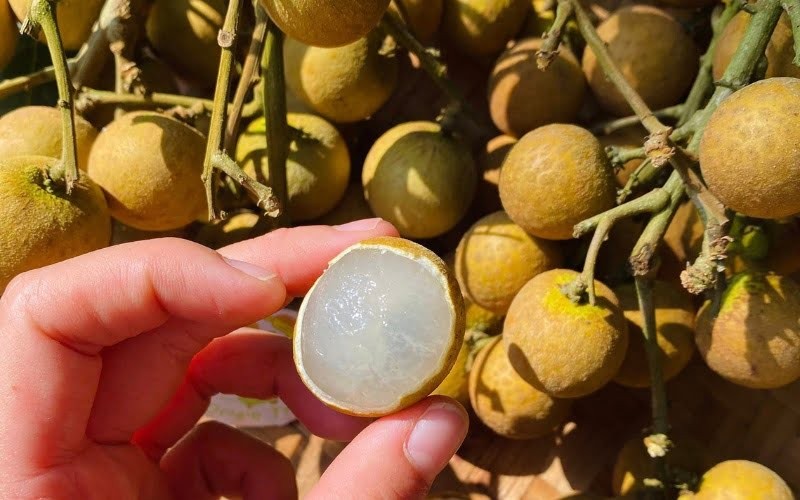 Close-up of Longan Fruit Revealing Translucent Flesh
Close-up of Longan Fruit Revealing Translucent Flesh
Alt Text: A detailed view of a Vietnamese longan, showcasing its translucent flesh and dark brown seed, highlighting the fruit’s appealing texture.
-
Flavor Profile: The flavor of a longan is distinctly sweet, often described as musky, with a juicy texture that offers a slight crispness. The sweetness is balanced with a unique aftertaste that lingers pleasantly. Many people enjoy the subtle aroma released when the fruit is peeled, adding to the overall sensory experience.
-
How to Enjoy: Longans can be enjoyed in numerous ways. They are delightful when eaten fresh, making for a quick and healthy snack. They can also be added to fruit salads, desserts, or used to create longan syrup and refreshing drinks. The versatility of longans makes them a popular ingredient in various Vietnamese dishes.
-
Harvest Season: The longan harvest season in Vietnam typically runs from July to October. This is the best time to find fresh, high-quality longans at local markets and farms. During this period, the fruit is at its peak in terms of flavor and nutritional value.
According to the Vietnam National Administration of Tourism, the longan harvest season attracts numerous tourists who wish to experience the local agricultural practices and enjoy the freshest produce. SIXT.VN can help arrange tours to these regions, providing a unique cultural and culinary experience.
2. What Makes Hung Yen Longans So Special?
Hung Yen province, located in the Red River Delta of Vietnam, is renowned for producing the most exceptional longans in the country. The unique combination of fertile soil, favorable climate, and traditional farming techniques contribute to the distinctive qualities of Hung Yen longans. These factors result in a fruit that is larger, juicier, and sweeter than longans grown in other regions.
-
Geographical Advantage: Hung Yen’s location in the Red River Delta provides the ideal conditions for longan cultivation. The alluvial soil, rich in nutrients, combined with a tropical monsoon climate, ensures that the longan trees receive ample sunlight and water. These conditions promote healthy growth and fruit development.
-
Traditional Farming Practices: Farmers in Hung Yen have honed their longan cultivation techniques over centuries. These traditional practices, passed down through generations, emphasize natural and sustainable methods. This includes careful pruning, fertilization with organic matter, and pest control using natural solutions.
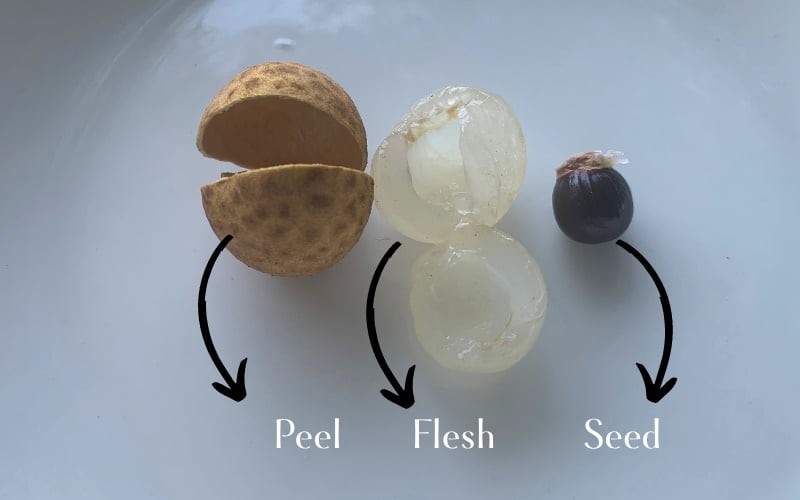 Longan Tree in Hung Yen with Abundant Fruit
Longan Tree in Hung Yen with Abundant Fruit
Alt Text: A lush longan tree in Hung Yen, heavily laden with ripe fruits, illustrating the region’s favorable conditions for longan cultivation.
-
Unique Variety: The “nhãn lồng Hưng Yên” variety is specifically cultivated in Hung Yen. This variety is known for its large size, thick pulp, intense sweetness, and distinct aroma. Historically, this particular longan was so prized that it was chosen as a royal offering to the king each year, highlighting its exceptional quality.
-
Taste and Texture: Hung Yen longans are celebrated for their unparalleled taste and texture. The flesh is exceptionally juicy and tender, with a pronounced sweetness that is perfectly balanced. The fruit offers a delightful crispness, making each bite a refreshing and satisfying experience.
According to a study by the Fruit and Vegetable Research Institute of Vietnam, Hung Yen longans have a higher sugar content and a more complex flavor profile compared to other longan varieties. This research supports the claim that Hung Yen longans are indeed special due to their unique characteristics.
3. What Does Vietnamese Longan Taste Like?
Vietnamese longans offer a unique and delightful flavor experience that sets them apart from other fruits. The taste can be described as a combination of sweetness, a hint of musky flavor, and a juicy texture.
-
Sweetness: The dominant flavor of a longan is its intense sweetness. This sweetness is natural and not overpowering, making it a refreshing treat. The sugar content is balanced, providing a satisfying taste without being cloying.
-
Musky Undertones: Alongside the sweetness, there is a subtle musky undertone that adds complexity to the flavor profile. This musky flavor is delicate and enhances the overall taste, making it unique and memorable.
-
Juicy Texture: The texture of the longan contributes significantly to its appeal. The flesh is incredibly juicy, providing a burst of flavor with each bite. There is also a slight crispness that adds to the satisfying mouthfeel.
-
Aromatic Qualities: When you peel a longan, it releases a gentle and pleasant aroma that further enhances the sensory experience. This aroma is subtly floral and sweet, making the fruit even more enticing.
 Close-up of Peeled Longan Showing Juicy Flesh
Close-up of Peeled Longan Showing Juicy Flesh
Alt Text: A close-up shot of a peeled longan, emphasizing its juicy and translucent flesh, inviting viewers to experience its delightful taste.
Many people compare the taste of longan to that of lychee, but there are distinct differences. While both fruits are sweet and juicy, longan has a more musky and less acidic flavor compared to lychee’s slightly tart and floral taste. According to culinary experts at the Vietnam Culinary Association, the unique taste of longan makes it a versatile ingredient in both sweet and savory dishes.
4. Longan vs Lychee: What Are The Key Differences?
Longan and lychee are often confused due to their similar appearance and sweet taste. However, there are several key differences that set these two fruits apart. Understanding these distinctions can help you appreciate each fruit’s unique qualities.
-
Shape and Appearance: Longans are round with a thin, brown, leathery skin. Lychees, on the other hand, are round or heart-shaped with a rough, pink or red rind. The skin of the lychee is also more textured compared to the smoother skin of the longan.
-
Texture: The texture of longan flesh is thinner and slightly crispier than lychee. Lychee flesh is softer, juicier, and has a jelly-like consistency. This difference in texture contributes significantly to the overall eating experience.
-
Taste: Longans have a sweet and musky flavor, while lychees have a sweet taste with a hint of sourness and a perfumed flavor. The lychee’s flavor is often described as more floral and aromatic compared to the longan’s musky sweetness.
Here is a quick comparison table:
| Feature | Longan | Lychee |
|---|---|---|
| Shape | Round | Round or Heart-Shaped |
| Skin Color | Brown | Pink or Red |
| Skin Texture | Smooth | Rough |
| Flesh Texture | Thin and Slightly Crispy | Soft and Jelly-like |
| Taste | Sweet and Musky | Sweet, Slightly Sour, Perfumed |
 Comparison of Longan and Lychee Fruits
Comparison of Longan and Lychee Fruits
Alt Text: A side-by-side comparison of longan and lychee, highlighting the differences in shape, skin color, and texture to help distinguish between the two fruits.
While both longan and lychee are delicious tropical fruits, their distinct characteristics make them appealing in different ways. Whether you prefer the musky sweetness of longan or the floral tartness of lychee, both fruits offer a unique and enjoyable culinary experience.
5. How Do You Eat a Vietnamese Longan?
Eating a Vietnamese longan is a simple and enjoyable process. The fruit is easy to peel and can be eaten fresh, making it a convenient and healthy snack.
-
Peeling the Longan: The skin of a longan is thin and easy to peel. Simply use your thumbs to gently remove the outer layer. You can also make a light cut with a knife to peel it off more easily. The skin should come off without much effort, revealing the translucent flesh inside.
-
Separating the Flesh from the Seed: After peeling, you can pop the longan into your mouth and use your teeth to separate the flesh from the seed. Be careful not to chew or swallow the seed, as it is not edible. Alternatively, you can use your fingers to remove the flesh from the seed before eating it.
-
Enjoying the Fruit: Once the flesh is separated from the seed, you can savor the sweet and juicy flavor of the longan. The fruit is best enjoyed fresh, allowing you to fully appreciate its unique taste and texture.
 Peeling and Eating a Longan Fruit
Peeling and Eating a Longan Fruit
Alt Text: A step-by-step visual guide on how to peel a longan, demonstrating the easy removal of the outer skin to reveal the edible flesh.
Longans can also be used in various culinary preparations. They can be added to fruit salads, desserts, or used to make refreshing drinks. The versatility of longans makes them a popular ingredient in Vietnamese cuisine.
6. What Are The Nutritional Benefits of Longan?
Longans are not only delicious but also packed with essential nutrients that offer numerous health benefits. Including longans in your diet can contribute to overall well-being and vitality.
-
Vitamin C: Longans are an excellent source of Vitamin C, an essential nutrient that supports the immune system, protects against oxidative stress, and promotes healthy skin. A 100-gram serving of longan provides a significant amount of your daily Vitamin C requirement.
-
Potassium: This fruit is also rich in potassium, an important mineral that helps regulate blood pressure, maintain fluid balance, and support muscle function. Adequate potassium intake is crucial for cardiovascular health.
-
Energy: Longans provide a good source of energy due to their carbohydrate content. The natural sugars in longans offer a quick and sustained energy boost, making them an ideal snack for active individuals.
-
Fiber: Longans contain dietary fiber, which aids in digestion, promotes gut health, and helps regulate blood sugar levels. Fiber also contributes to feelings of fullness, which can assist in weight management.
Here’s a nutritional breakdown for a 3.5-ounce (100-gram) serving of longan, based on data from the USDA:
| Nutrient | Amount |
|---|---|
| Vitamin C | 84 mg |
| Potassium (K) | 266 mg |
| Energy | 60 kcal |
| Carbohydrate, by difference | 15.1 g |
| Fiber | 1.1 g |
| Protein | 1.31 g |
| Total lipid (fat) | 0.1 g |
| Magnesium (Mg) | 10 mg |
| Iron (Fe) | 0.13 mg |
| Sodium (Na) | 0 mg |
According to the National Institutes of Health, Vitamin C and potassium are essential for maintaining optimal health. Longans provide a convenient and delicious way to incorporate these nutrients into your diet.
7. How To Pick The Best Vietnamese Longans
Choosing the best Vietnamese longans involves considering several factors to ensure you select fruits that are ripe, fresh, and flavorful. Here are some tips to help you pick the most delicious longans:
-
Appearance: Look for bunches that come with stems, as this indicates freshness. The fruit should have a shiny, firm skin and vibrant color. Avoid fruits that are leaking juice, mushy, damp, have cracked skins, or show dark spots.
-
Aroma: Fresh longans should have a pleasant aroma. If the fruit has little to no smell, it may not be ripe. A strong, sweet fragrance is a good sign of quality.
-
Texture: Gently squeeze the longan with your fingers. If it feels slightly soft but not too firm, it’s a sign that the fruit is juicy and ripe. Overly hard or mushy longans should be avoided.
-
Leaves: Check the leaves on the longan bunches. Fresh leaves that emit a pleasant aroma are a good indicator of overall quality.
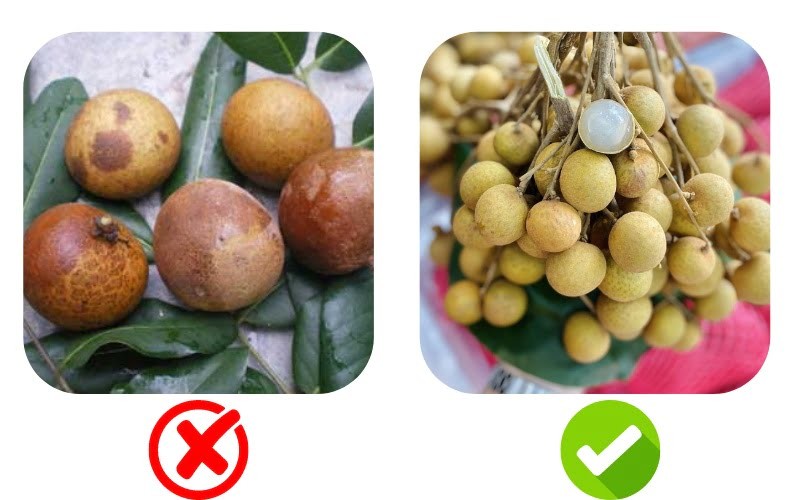 Selecting Fresh Longan at a Local Market
Selecting Fresh Longan at a Local Market
Alt Text: A person carefully selecting fresh longans at a local market, examining the skin and stems to ensure ripeness and quality.
By following these tips, you can ensure that you choose the best Vietnamese longans and enjoy their delicious taste and nutritional benefits. Farmers’ markets and local fruit vendors often offer the freshest and highest-quality longans.
8. How Should Longans Be Stored To Keep Them Fresh?
Proper storage is essential to maintain the freshness and flavor of longans. Following these simple steps will help extend their shelf life and keep them tasting delicious for days.
-
Step 1: Rinse and Snip: Give the longans a good rinse under cool running water, then gently snip them off the branches. Set them aside to air dry.
-
Step 2: Inspect and Discard: Carefully inspect the longans, discarding any that are bruised, overly soft, or show signs of mold or pests.
-
Step 3: Store in Vented Bags: Transfer the longans to vented plastic bags to keep them fresh, then pop them into the crisper drawer of your fridge. This will help maintain their moisture and prevent them from drying out.
Following these steps will help keep your longans fresh and tasty for longer. Properly stored longans can last up to a week in the refrigerator.
9. How are Longans used in Traditional Vietnamese Medicine?
In traditional Vietnamese medicine, longans are highly valued for their medicinal properties. They are often preserved by drying the fruit, which concentrates their beneficial compounds.
-
Drying Process: After drying, longans develop a rich yellow or dark brown color. The dried longans become soft and chewy, with a sweet flavor and a subtle, distinctive aroma.
-
Medicinal Uses: Dried longans are used alone or combined with other herbs to create remedies for various conditions. They are believed to boost energy, improve memory, and combat skin aging.
-
Boosting Energy: Traditional practitioners prescribe dried longans to individuals experiencing fatigue or weakness. The fruit’s natural sugars and nutrients are thought to revitalize the body and enhance overall energy levels.
-
Improving Memory: Longans are also used to improve cognitive function and memory. They are believed to enhance blood flow to the brain and protect against age-related cognitive decline.
-
Combating Skin Aging: The antioxidants in longans are thought to protect the skin from damage caused by free radicals. This can help reduce the appearance of wrinkles and other signs of aging.
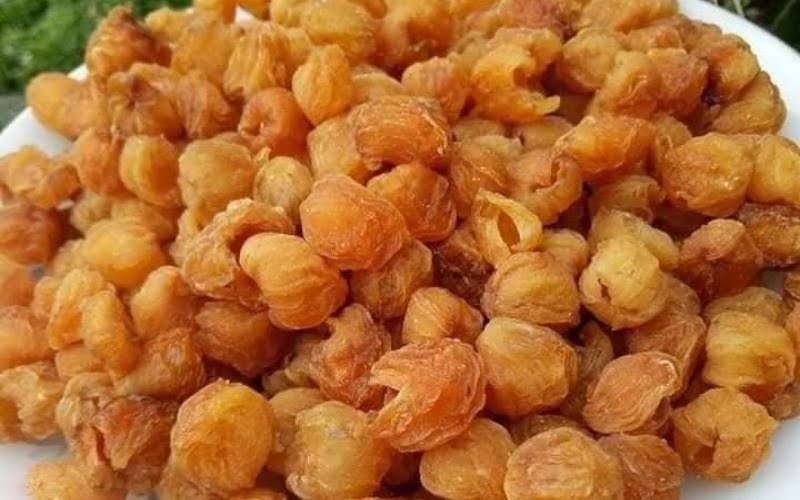 Dried Longans Used in Traditional Medicine
Dried Longans Used in Traditional Medicine
Alt Text: Dried longans displayed as a traditional medicine ingredient, highlighting their use in boosting energy, improving memory, and combating skin aging.
While these uses are based on traditional Vietnamese medicine, it’s important to note that scientific research has not yet fully confirmed or disproved these claims. Always consult with a healthcare professional before using longans for medicinal purposes.
10. What are Some Traditional Vietnamese Longan Recipes?
Longans are a versatile ingredient in Vietnamese cuisine, used in both sweet and savory dishes. Here are a couple of traditional recipes that showcase the unique flavor of longans:
10.1. Vietnamese Longan and Lotus Seed Sweet Soup (Chè Nhãn Nhục)
This sweet soup is a popular dessert in Vietnam, combining the sweetness of longans with the subtle flavor of lotus seeds.
-
Ingredients:
- Fresh lotus seeds
- Fresh longans
- Rock sugar
- Water
- Ice cubes (for serving chilled)
-
Instructions:
- Boil the fresh lotus seeds until tender, then drain and set them aside.
- Carefully peel the longans, making sure to remove the seeds while keeping the fruit whole.
- Gently stuff each lotus seed into the hollowed-out longans.
- In a pot, dissolve the rock sugar in water and bring it to a simmer.
- Add the stuffed longans and let them cook briefly—just enough for them to soak up the sweet syrup.
- Remove the pot from heat and let the soup cool to room temperature.
- Chill the soup in the refrigerator before serving.
- Ladle the soup into bowls, garnishing with extra lotus seeds and ice cubes.
10.2. Longan Tea
Longan tea is a refreshing and aromatic beverage that is perfect for a warm day.
-
Ingredients:
- Fresh longans
- Jasmine tea bags
- Rock sugar
- Granulated sugar
- Water
- Ice cubes
- Salt
-
Instructions:
- Peel the longans, remove the seeds, and rinse the fruit with warm water.
- Sweeten the longan flesh with granulated sugar and let it sit for about 15 to 20 minutes.
- In a pot, bring water to a boil with rock sugar and a pinch of salt.
- Once the sugar and salt have dissolved, add the sweetened longan flesh and cook until the longans turn opaque and the syrup thickens. Then remove from heat.
- Steep the jasmine tea bags in hot water for about 5 to 8 minutes.
- Combine some jasmine tea with a portion of the longan syrup and a few ice cubes. Stir well, pour into a glass, and enjoy!
These recipes offer a glimpse into the culinary versatility of longans and their importance in Vietnamese cuisine.
11. Which Areas In Vietnam Are Known For Growing Longans?
Longan trees thrive in various regions of Vietnam, with the largest cultivation areas found in the Mekong Delta and northern parts of the country. However, Hung Yen Province is the most famous longan-growing area, known for its exceptional “Hung Yen Longan.”
-
Mekong Delta: The Mekong Delta region benefits from its fertile soil and tropical climate, making it ideal for longan cultivation. Provinces such as Dong Thap, Vinh Long, and Ben Tre are significant producers of longans.
-
Northern Vietnam: In northern Vietnam, longans are also grown in provinces such as Bac Giang, Hai Duong, and Hung Yen. The Red River Delta provides favorable conditions for longan cultivation.
-
Hung Yen Province: Hung Yen is particularly renowned for its longans, which are considered the best in the country. The unique soil and climate conditions, combined with traditional farming practices, contribute to the superior quality of Hung Yen longans.
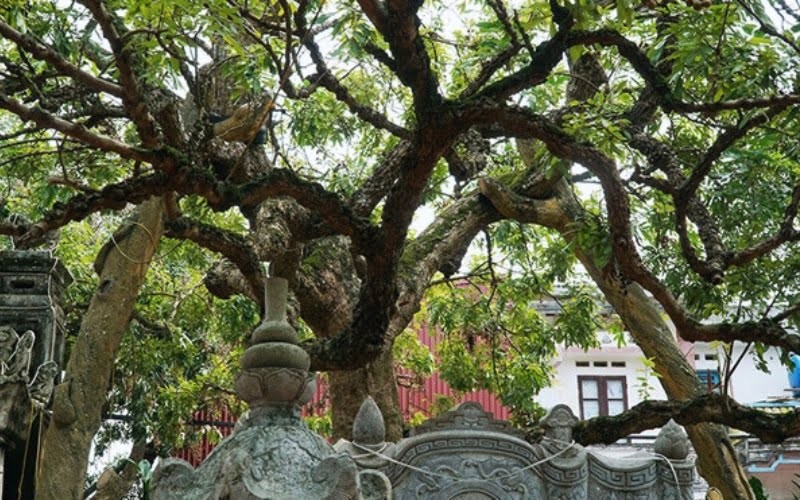 400-Year-Old Longan Tree in Hung Yen
400-Year-Old Longan Tree in Hung Yen
Alt Text: The historic 400-year-old longan tree in Hung Yen Province, a symbol of the region’s long-standing tradition of longan cultivation.
Visiting these regions during the harvest season offers a unique opportunity to experience the local culture and enjoy the freshest longans. SIXT.VN can arrange tours to these agricultural areas, providing a memorable and authentic travel experience.
12. Frequently Asked Questions (FAQs) About Hung Yen Longans
12.1. What makes Hung Yen longans different from other longans?
Hung Yen longans are known for their larger size, thicker pulp, intense sweetness, and distinct aroma, thanks to the region’s unique soil and traditional farming practices.
12.2. When is the best time to visit Hung Yen for longan season?
The best time to visit Hung Yen for longan season is from July to October when the fruit is at its peak in terms of flavor and availability.
12.3. Can I visit longan farms in Hung Yen?
Yes, many longan farms in Hung Yen welcome visitors during the harvest season, offering tours and the opportunity to pick your own fruit. SIXT.VN can help arrange these visits.
12.4. How can I tell if a longan is ripe?
A ripe longan should have a shiny, firm skin, a vibrant color, and a slightly soft texture when gently squeezed.
12.5. Are longans good for my health?
Yes, longans are rich in Vitamin C, potassium, and fiber, offering numerous health benefits, including boosting the immune system and aiding digestion.
12.6. How should I store longans to keep them fresh?
Store longans in vented plastic bags in the crisper drawer of your refrigerator to maintain their freshness for up to a week.
12.7. What are some popular dishes made with longans?
Popular dishes made with longans include Vietnamese longan and lotus seed sweet soup (chè nhãn nhục) and longan tea.
12.8. Where can I buy authentic Hung Yen longans?
You can buy authentic Hung Yen longans at local markets in Hung Yen province or from reputable fruit vendors throughout Vietnam.
12.9. Are there any traditional uses of longans in Vietnamese medicine?
Yes, in traditional Vietnamese medicine, dried longans are used to boost energy, improve memory, and combat skin aging.
12.10. How do longans compare to lychees in terms of taste and texture?
Longans have a sweet and musky flavor with a slightly crispy texture, while lychees have a sweet, slightly sour, and perfumed flavor with a soft, jelly-like texture.
Planning a trip to Vietnam to taste the famous Hung Yen longans? Let SIXT.VN take care of all your travel needs. We offer reliable airport transfers, comfortable hotel bookings, and guided tours to help you explore the best of Vietnam. Contact us today to start planning your unforgettable journey:
Address: 260 Cau Giay, Hanoi, Vietnam
Hotline/Whatsapp: +84 986 244 358
Website: SIXT.VN
Discover the sweetness of Hung Yen longans and the beauty of Vietnam with SIXT.VN.



